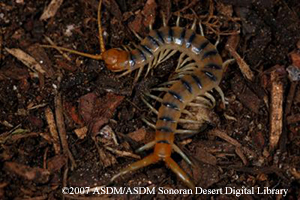Animal Fact Sheet: Desert Centipede |
Identifying Features There are two types of centipedes living in the Sonoran Desert. One is the giant desert centipede (Scolopendra heros), and the other is the common desert centipede (Scolopendra polymorpha). They both can be identified by their flattened body made of many segments. There is one pair of legs for each segment except for the first and last segments. One pair of antennae are located on the head. The giant centipede has an orange body with a black head and tail. The common centipede is tan and brown. |
 |
Adaptations Centipedes use structures called gnathosomes or gnathopods to inject venom into their prey. These are paired pincer-like appendages in front of the legs. The “bite” is actually a pinch. |
Habitat In general, centipedes can live in a wide variety of habitats. They can be found not only in a desert habitat, but also in the tropics, and at the seashore. Centipedes can be found under stones, logs, bark, in crevices, and in litter and soil. |
Range The two species of desert centipedes are found throughout the southern United States and into Mexico. |
Wild Status Desert centipedes are currently doing fine in the wild and have no special conservation status. |
Diet They are carnivores eating such foods as insects, lizards, frogs, and rodents. |
Predators Predators include owls, coyotes, ringtail, bobcats and badgers. |
Home During the daytime centipedes will spend their time underground or under rocks, bricks, potted plants, etc. concealed from the sun. |
Life Span Very little is known about the life span of the desert centipede. it is estimated that they live over 5 years. |
Size The giant centipede can reach a length of 6 to 8 inches. The common centipede is smaller about 4 to 5 inches. |
Extra Fun-facts
|
 ©Copyright 2008, Arizona-Sonora Desert Museum
©Copyright 2008, Arizona-Sonora Desert Museum










